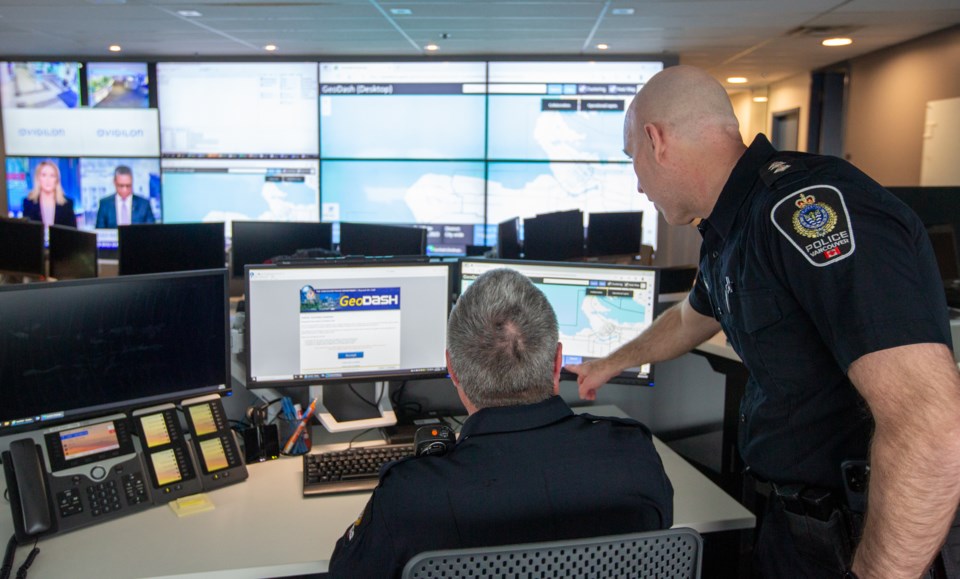The Vancouver Police Department has created a daily command centre inside its Cambie Street precinct to more effectively respond to calls and provide patrol officers with detailed data while en route to an incident or conducting an investigation.
That effectiveness also includes a desk for a drone pilot, who can launch the camera-equipped flying device from a computer inside the command centre, as he did recently in guiding officers to rescue a suicidal person from the Burrard Bridge.
“For our tactical members to go and rope up and get harnessed and go over [the railing] and make a rescue attempt, they can't see the person,” explained Insp. Brent Derksen during a tour of the centre.
"By positioning one of our drones below [the bridge deck], we can get live information and we can see the person, his location and that he doesn’t have a weapon or anything in his hands. Everyone is safer this way.”
That live feed is projected onto a series of large television screens on a wall of the centre, which is roughly the size of a school classroom. Staffed with officers and civilians, the centre has been fully operational 24 hours a day, seven days a week since October.
The drone is only one aspect of the centre, as Glacier Media learned in speaking to some of the officers who provide what Const. Brad Lawrence described as “a third arm” to officers on the road.
Stolen merchandise on Facebook
Depending on the nature of the call, an officer doesn’t always have time to make a phone call or use their vehicle laptop, which has access to much of the same data in the command centre but is not available at the speed a team of officers can quickly collect.
Lawrence shared a story about assisting an officer find the name of a woman wanted for selling stolen merchandise on Facebook. He conducted some online searches, pulled up police data and was able to match a tattoo of the suspect to the person’s name.
That same approach to mining data has also helped build more information for police when searching for a missing person. Staff can then quickly disseminate details, including a photo, to other agencies such as TransLink and Metro Vancouver Transit Police.
“They have cameras everywhere and they can help locate this missing person,” said Lawrence, who was working next to Sgt. Ryan Perry, who expanded on how he digs for more detailed information to assist officers.
“I always look for calls that lack detail [when dispatched],” Perry said. “Maybe we only have a first name or possible name. So we’ll do a history search of a location or a building to see if we can extract that name.”
'Everyone wins'
That additional information can be crucial when officers respond to an incident involving a violent person, or a person living with a mental illness. Depending on the call, deployment could mean using a tactical team or a less lethal approach.
“If we can delve into background and get that information out to our responding members — ideally, even before they get to the call — everyone wins, including the subject of the complaint because, ultimately, we have a better-informed response,” Derksen said.
He added that ever-changing technology and corresponding data available publicly and privately are helpful for officers, but it can be time-consuming to access or impractical to search when responding to an emergency.
“We have tons of information coming to us that should be readily accessible, but how do you do that driving around in a Ford Explorer?” Derksen said. “That gap has just become more and more apparent, and we needed to fill that gap. And ultimately, we needed a hub for that type of information.”
Staff at the centre can project live maps of the city on the screens that show the call load and where it is concentrated in the four policing districts. That visual helps staff decide where best to deploy the department’s roving police squads, also known as metro teams.
Triaging calls is also an important aspect of the command centre, with the team deciding which calls should have an officer attend versus an officer in the building prepare a report for follow-up with the caller.
On average, the VPD gets 600 to 700 calls per day. Some of those in the queue during Glacier Media’s tour included what police described as “the whole buffet” — assaults, a man with a knife, a missing person, a suicidal person, a shoplifter, break-and-enter and check on the well-being of a person.
'Seasons affect types of crime'
When a major incident occurs such as a recent Sunday afternoon shooting in the Downtown Eastside, the centre will kick into high gear to see how best it can assist, which could include building a profile on the suspect, mobilizing officers, alerting other police agencies and transit and ensuring other areas of the city maintain a police presence.
Only four months since it was created, the centre is demonstrating efficiencies — cutting time an officer spends on a shoplifting file was one example, quickly identifying persons was another — but Derksen said it will take some time to measure what works best and what needs to be improved.
“We're just months into this,” he said. “We haven't even run through more than a season, and seasons affect the types of crime and frequency and all that. So we're only going to be able to see really meaningful numbers after we've been at this a bit longer.”
Added Derksen: “It’s about refining our response wherever possible and looking for more likely places that we might intervene. It's an enhancement of what has been done in the past because we have the environment to make the best use of technology. And because we are very much in the build stage, that's just an ongoing project.”




